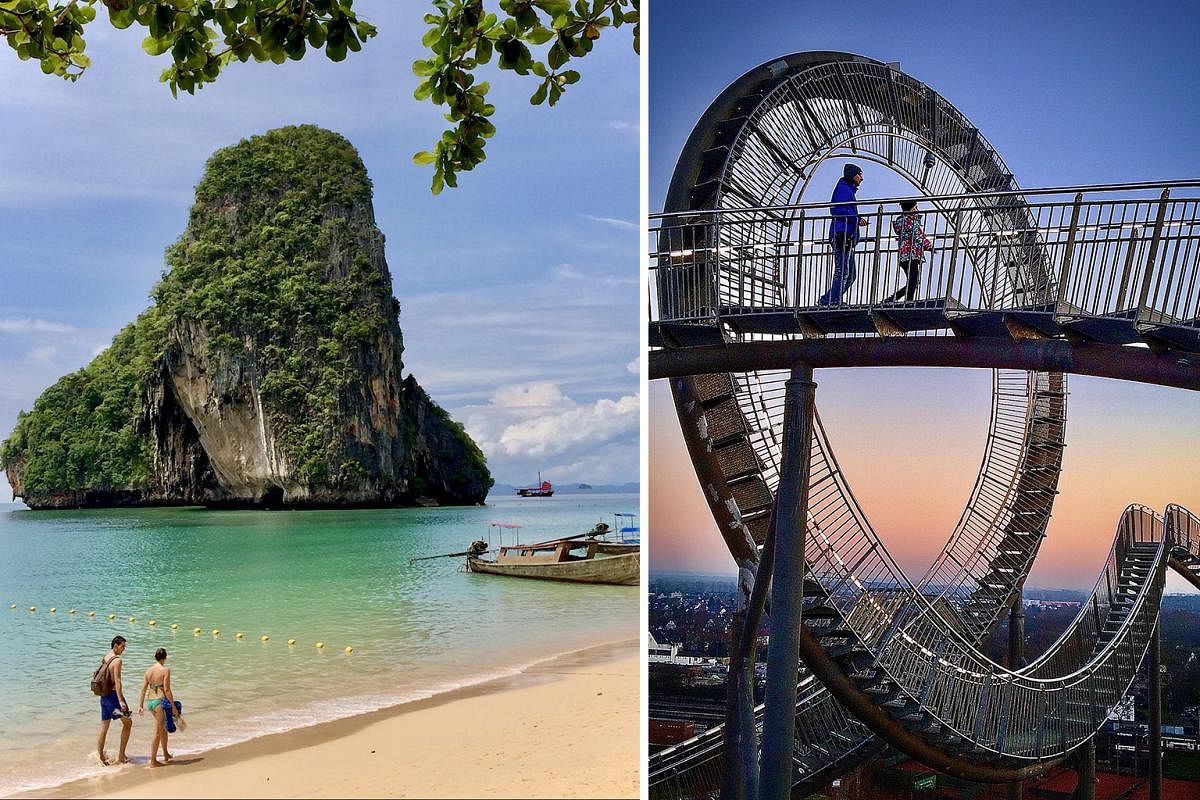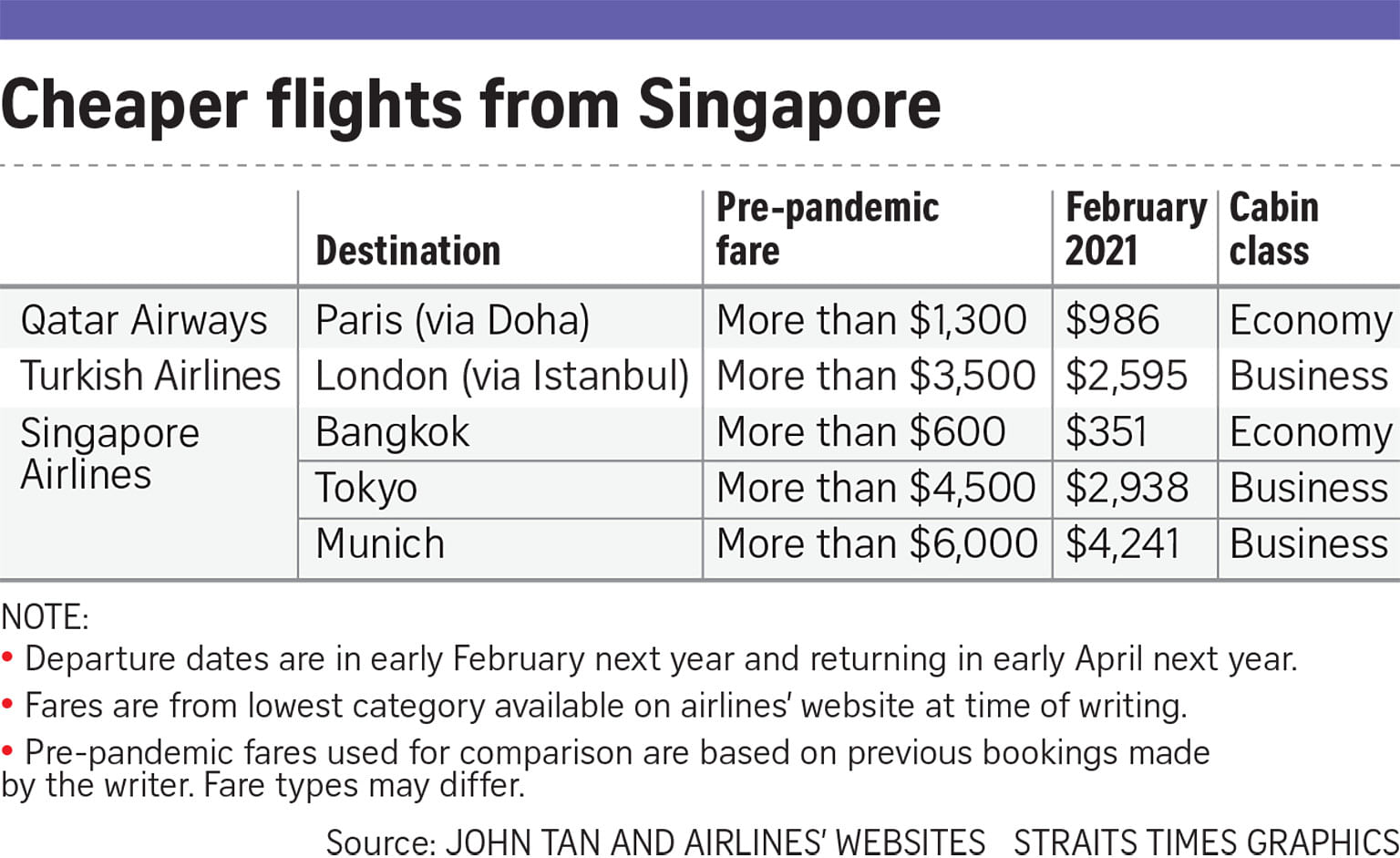Fly for less
The pandemic is far from over, but it is a good time to pick up airfares now for travel in the future


I just placed a $12,000 wager against the Covid-19 virus.
Yes, the pandemic is far from over. But I refuse to imagine that the world's borders will remain tightly closed for another 12 months, with leisure travel non-existent.
The vaccine is around the corner while travel bubbles will continue to brew. The Singapore-Hong Kong air travel bubble was postponed two days ago, but it is not fully deflated yet.
Meanwhile, airfares are available at bargain prices, paired with favourable booking terms and conditions.
So, I took the plunge and bought four air tickets for travel for next year. Here is why I have figured that the odds are in my favour.
LOWEST FARES IN HALF A DECADE
Internet searches conducted earlier this month show airfares for early next year going at bargain prices, compared with the pre-pandemic days last year. (The global travel industry started to falter from mid-January this year. In this light, January 2019 is a better benchmark for price comparisons).
Global travel search engine Skyscanner's data, at the point of writing, showed savings of up to 51 per cent on some routes for airfares for January and February next year, compared with the same period last year and in 2018 (see: Airfares likely to rise with news of vaccines).
"Three persons can fly for the cost of two persons now," says Mr S.H. Lim, a ticketing agent with a leading outbound operator with 20 years' experience.
Long-haul fares, in particular to Europe, plunged between 15 per cent and 25 per cent. Regional mid-haul flights to Japan and South Korea are good deals too.
Business class cabins have become more affordable. For example, Turkish Airlines offers business class from Singapore to London - transit via Istanbul - for only $2,595 (see table on Cheaper Flights From Singapore). Pre-pandemic, this price hardly got people beyond Asia in business class.
National carrier Singapore Airlines (SIA) offers round-trip business class flights to Tokyo for $3,000 - a sharp contrast to the $5,500 I usually forked out on that popular sector.
Pro tips:
• Fly business class for big savings.
• Check updates on the airline's financial status. Avoid airlines under financial restructuring or in dire cash-flow situations.
• Competing carriers, with a transit into their hubs, price their tickets at almost half of SIA's direct flights. But be mindful that the arrival destination's border entry rules may be different for transit flights.


GET A FREE SECTOR AND EVEN PAY LESS
My default carrier is SIA, given its loyalty programme and because my home base is Singapore.
For years, my favourite travel hack was to snag a free tag-on flight.
Now, coupled with low fares, this trick has morphed into: fly farther yet pay less.
A return SIA business class ticket for early February next year from Singapore to Tokyo costs $2,938 (see table on Fly Farther And Pay Less). But if I bookend the front and back of this itinerary with an extra Asean destination such as Bangkok, the fare drops to $2,173.
This savings of $765 can buy a five-night stay at the Grand Hyatt Bangkok, lots of happy hours at my favourite Thai massage haven and servings of Michelin-starred Jay Fai's crab omelette.
Over the past five years, I have used this Bangkok-Singapore-Japan hack half a dozen times and cannot recall such low business fares.
Another tag-on: Add a Ho Chi Minh City sector to Singapore and onwards to Paris on SIA and there is an eye-popping fare saving of $1,479 on business class and $88 on economy fares, compared with an itinerary that originates from Singapore.
Depending on fares and routes, the savings can run into thousands of dollars for families or big groups.
These Asean destinations are a short hop away, serviced by frequent inexpensive flights.
For those with spare time or have a flexible schedule, this is a free tag-on holiday. Stopovers in Singapore are also permitted, subject to fare rules.
No, neither the airfare wizards of SIA nor its algorithms got their permutations wrong.
Being the foreign carrier in those destinations, SIA needs to compete with the national carrier there. Conversely, SIA commands a premium for flights originating from its home base of Singapore.
Pro tips:
• Select tag-on flight sectors from countries with good schedules.
• Different "start and end" cities are permitted. For example, I can commence my SIA itinerary from Bangkok to Europe (via Singapore) and end my return journey in Phuket, so long as it involves the SIA group for the same country.
• Open jaw sectors are permitted, provided the sector is from the same zone. For example, the SIA flight may commence from Kuala Lumpur (via Singapore) to Paris - but the return route is from Munich instead. Such itineraries provide variety and avoid back-tracking.
FLEXIBILITY IS KEY, BUT KNOW THE RULES
"Nobody will buy a ticket today if there is no flexibility," says Mr Wong S.H., a travel industry veteran with 40 years' experience. The icing is the slew of unprecedented flexible ticketing terms.
To entice travellers to buy tickets before Dec 31 this year, airlines dangle free changes on dates, re-routing, refunds and travel credits for future travel.
Each carrier has its set of terms and conditions.
Most airlines group their fares into three categories, starting with the lowest, most restrictive fare - in both economy and business classes - being non-refundable. The other two higher-fare genres allow refunds for a fee.
Regardless of fare types, all tickets are valid for a year.
Among the most generous is Qatar Airways, which offers ticket validity for two years; unlimited changes until Dec 31 next year; exchange for travel voucher with bonus; full refund for flight cancellations by the airline; and swopping the ticket for air miles.
I bought the lowest-tier non-refundable SIA business class ticket to Japan for travel next February.
For me, Japan is a yearly foodie pilgrimage and I am betting against the possibility the country will be shuttered for another year. If things are still sketchy come February, I can always push back the travel dates.
Pro tips:
• Check the fine print.
• Buy non-refundable tickets to your favourite destinations or a must-do trip. But fret not as non-refundable tickets allow a rebooking for a new itinerary or date, subject to fare differences and fees.
• For trips that are less certain, opt for refundable tickets. These cost a few hundred dollars more, with refund administrative fees, but you get the cash back immediately. I would opt for refundable tickets if they are high-value fares.
FREQUENT CHANGES ARE COSTLY: REQUEST AN OPEN-DATED TICKET
For tickets bought before Dec 31 this year, SIA offers a single complimentary rebooking for travel next year. Fees for subsequent rebookings will cost between $25 and $340, depending on fare type and cabin class.
However, competitors - such as Cathay Pacific, Qatar Airways and Turkish Airlines - offer unlimited changes until end-December next year.
Given the stiff competition, industry observers say SIA is likely to offer some match-up in the future.
When contacted, SIA cited "commercial sensitivity" and declined to provide more details on its future plans.
Pro tips:
• Frequent changes can be costly. My ticket is based on my most likely travel date to minimise the chance of an aborted trip. If the original departure date is called off and there is uncertainty ahead, I will request to amend the ticket to an open date. This is free.
• When my travel dates are firm, I will lock in the new dates and have a ticket reissued. This qualifies for the one-time complimentary change, subject to any fare difference.
EXTENDING THE USE OF YOUR TICKET BEYOND A YEAR
Though tickets are valid for a year, there is a trick to extend its monetary lifespan.
Before the one-year expiry, a ticket may be reissued with a new itinerary or different fare type. The reissued ticket receives a new lifespan of 12 months. You can reissue again and again, but there are rebooking fees each time.
However, Prime Minister Lee Hsien Loong does not foresee international travel returning to normal next year.
"Maybe in two years' time, it would be possible to extend in a bigger way," he said at a virtual event associated with the Asia-Pacific Economic Cooperation (Apec) grouping last Thursday.
Still, my ticket punt lies in my faith that leisure travel will return.
Fares will skyrocket whenever a travel restriction eases or as travel confidence picks up.
The recent slew of positive vaccine news is like a shot in the arm for me - I ended up buying tickets to the United States and Europe for summer/autumn next year, in addition to my original plan for a Japan trip.
I am sure SIA will appreciate my ticket purchases more than a dining ticket in its parked aircraft.
• Pre-pandemic, John Tan, a former journalist, had averaged some 70 flights a year over the past decade. His most expensive ticket was a round-the-world Star Alliance business class fare, which cost more than $16,000. But his most memorable was a no-frills $18 Ryanair flight from Bucharest to Rome.
Join ST's Telegram channel and get the latest breaking news delivered to you.
A version of this article appeared in the print edition of The Straits Times on November 24, 2020, with the headline Fly for less. Subscribe
